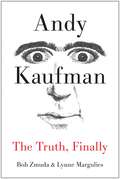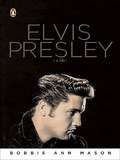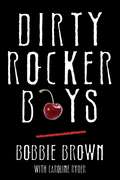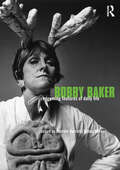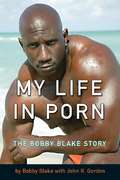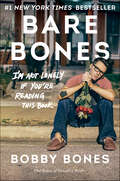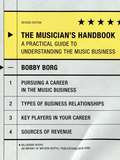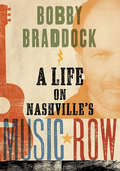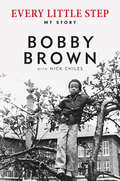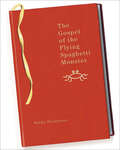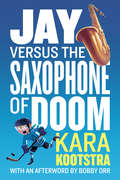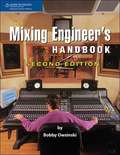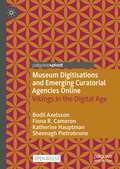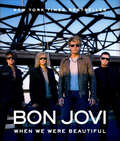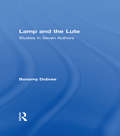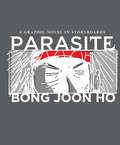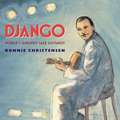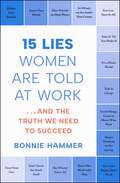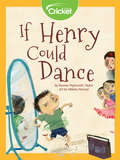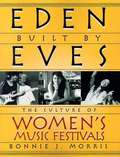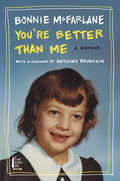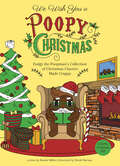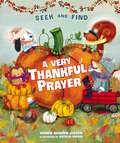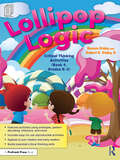- Table View
- List View
Andy Kaufman: The Truth, Finally
by Bob Zmuda Lynne MarguliesFor the first time ever, the two people who knew Andy Kaufman best open up about the most enigmatic artist of our generation. Comedian and Taxi star Andy Kaufman, known for his crazy antics on screen and off, was the ultimate prankster, delighting audiences with his Elvis and Mighty Mouse impressions while also antagonizing them with his wrestling and lounge-lizard alter ego, Tony Clifton. Some say he died in 1984, while others believe he performed the ultimate vanishing act. In Andy Kaufman: The Truth, Finally, Bob Zmuda, Andy's writer and best friend, and Lynn Margulies, the love of Andy's life, reveal all—including surprising secrets that Andy made Lynne and Bob promise never to tell until both of his parents had died. Hilarious and poignant, this book separates fact from fiction, and includes a candid inside look at the Milos Forman film Man on the Moon, which Zmuda coexecutive produced and featured Jim Carrey as Andy, Paul Giamatti as Zmuda, Courtney Love as Margulies, and Danny DeVito as Andy's manager, George Shapiro. Finally, Bob Zmuda shares in detail the reasons he believes Andy Kaufman did, in fact, fake his own death, including exactly how he did it and why he will return.
Elvis Presley
by Bobbie Ann MasonA vibrant, sympathetic portrait of the once and future king of rock ?n? roll by the award-winning author of Shiloh and In Country To this clear-eyed portrait of the first rock ?n? roll superstar, Bobbie Ann Mason brings a novelist?s insight and the empathy of a fellow Southerner who, from the first time she heard his voice on the family radio, knew that Elvis was ?one of us. ? Elvis Presley deftly braids the mythic and human aspects of his story, capturing both the charismatic, boundary-breaking singer who reveled in his celebrity and the soft-spoken, working-class Southern boy who was fatally unprepared for his success. The result is a riveting, tragic book that goes to the heart of the American dream. .
Dirty Rocker Boys
by Caroline Ryder Bobbie BrownAn uncensored Hollywood tell-all filled with explicit tales of love, sex, and revenge from the video vixen made famous by Warrant’s rock anthem “Cherry Pie.”Who could forget the sexy “Cherry Pie” girl from hair metal band Warrant’s infamous music video? Bobbie Brown became a bona fide vixen for her playful role as the object of lead singer Jani Lane’s desires. But the wide-eyed Louisiana beauty queen’s own dreams of making it big in Los Angeles were about to be derailed by her rock-and-roll lifestyle. After her tumultuous marriage to Jani imploded, and her engagement to fast-living Mötley Crüe drummer Tommy Lee ended in a drug haze—followed by his marriage later to Pamela Anderson—Bobbie decided it was time Hollywood’s hottest bachelors got a taste of their own medicine. Step one: get high. Step two: get even. In a captivating, completely uncensored confessional, Bobbie explicitly recounts a life among some of the most famous men in Hollywood: Leonardo DiCaprio, Kevin Costner, Mark McGrath, Dave Navarro, Sebastian Bach, Ashley Hamilton, Rob Pilatus of Milli Vanilli, Matthew and Gunnar Nelson, Orgy’s Jay Gordon, and many more. No man was off limits as the fun-loving bombshell spiraled into excess, anger, and addiction. Bobbie survived the party—barely—and her riveting, cautionary comeback tale is filled with the wildest stories of sex, drugs, and rock and roll ever told.
Bobby Baker: Redeeming Features of Daily Life
by Michèle Barrett Bobby BakerBobby Baker is one of most widely acclaimed and popular performance artists working today. Over the course of a thirty-five-year career she has toured the globe with her wildly stimulating explorations of 'Daily Life' and has been extensively written about and studied. This fully-illustrated book brings together for the first time an account of Baker's career as an artist – from her first sculptures at Central St Martins in the early 1970s to her most recent work, 'How to Live' and 'Diary Drawings' – with critical commentary by reviewers and academic practitioners. It includes: Bobby Baker's own 'Chronicle' of her work as artist and performer illuminating critical writing about Baker's shows transcripts of Baker's performances and other original materials reproduced here for the first time significant new essays by Michele Barrett and Griselda Pollock a new interview with Bobby Baker by Adrian Heathfield. Under the guiding editorial hand of distinguished cultural theorist Michèle Barrett, this volume is an essential text for students interested in performance, gender, and visual culture, and a hugely absorbing and accessible account of Baker's work.
My Life in Porn: The Bobby Blake Story
by Bobby BlakeThe most successful African American in gay adult film, Bobby Blake has appeared in over one hundred movies. In My Life in Porn, Blake for the first time goes behind the scenes of the sex industry to reveal intimate stories that are sexy, fascinating, and sometimes disturbing. Blake also shares his private spiritual struggle and the quest for love.
Bare Bones: I'm Not Lonely If You're Reading This Book
by Bobby Bones#1 New York Times BestsellerA touching, funny, heart-wrenching, and triumphant memoir from one of the biggest names in radio, the host of The Bobby Bones Show, one of the most listened-to drive time morning radio shows in the nation.Growing up poor in Mountain Pine, Arkansas, with a young, addicted mom, Bobby Estell fell in love with country music. Abandoned by his father at the age of five, Bobby saw the radio as his way out—a dream that came true in college when he went on air at the Henderson State University campus station broadcasting as Bobby Bones, while simultaneously starting The Bobby Bones Show at 105.9 KLAZ. Bobby’s passions were pop, country music, and comedy, and he blended the three to become a tastemaker in the country music industry, heard by millions daily. Bobby broke the format of standard country radio, mixing country and pop with entertainment news and information, and has interviewed some of the biggest names in the business, including Luke Bryan, Taylor Swift, Blake Shelton, Tim McGraw, Lady Antebellum, and Jason Aldean.Yet despite the glamour, fame, and money, Bobby has never forgotten his roots, the mom and grandmother who raised him, the work ethic he embraced which saved him and encouraged him to explore the world, and the good values that shaped him. In this funny, poignant memoir told in Bobby’s distinctive patter, he takes fans on a tour of his road to radio. Bobby doesn’t shy away from the curves he continues to navigate—including his obsessive-compulsive disorder—on his journey to find the happiness of a healthy family.Funny and tender, raw and honest, Bare Bones is pure Bobby Bones—surprising, entertaining, inspiring, and authentic.
The Musician's Handbook: A Practical Guide To Understanding The Music Business (Revised Edition)
by Bobby BorgThe bible of the music biz; now fully revised with new contacts, fee info, trends, tips. Want to know how to set prices for a gig? Want to be ahead of the curve on new trends in music? Want to have all the latest contact information on hundreds of industry pros? Have we got the book for you! The Musician's Handbook, already the industry bible for working musicians, has been thoroughly revised and updated with the answers to all these questions and more. New interviews with music-business leaders, new pricing and legal structures for the digital age, new how-to tips for independent and do-it-yourself musician -- it's all in here. Fees, royalties and advances, live performance, touring, merchandising, working with managers, lawyers, and agents, spotting new opportunities -- all these topics and many, many more are covered in depth in this indispensable guide to becoming successful in music and in business.
Bobby Braddock: A Life on Nashville's Music Row (Co-published with the Country Music Foundation Press)
by Bobby BraddockIf you know country music, you know Bobby Braddock. Even if you don't know his name, you know the man's work. "He Stopped Loving Her Today." "D-I-V-O-R-C-E." "Golden Ring." "Time Marches On." "I Wanna Talk About Me." "People Are Crazy." These songs and numerous other chart-topping hits sprang from the mind of Bobby Braddock. A working songwriter and musician, Braddock has prowled the streets of Nashville's legendary Music Row since the mid-1960s, plying his trade and selling his songs. These decades of writing songs for legendary singers like George Jones, Tammy Wynette, and Toby Keith are recounted in Bobby Braddock: A Life on Nashville's Music Row, providing the reader with a stunning look at the beating heart of Nashville country music that cannot be matched. If you're looking for insight into Nashville, the life of music in this town, and the story of a force of nature on the Row to this day, Bobby Braddock will take you there.
Bobby Braddock: A Life on Nashville’s Music Row (Co-published with the Country Music Foundation Press)
by Bobby BraddockIf you know country music, you know Bobby Braddock. Even if you don't know his name, you know the man's work. "He Stopped Loving Her Today." "D-I-V-O-R-C-E." "Golden Ring." "Time Marches On." "I Wanna Talk About Me." "People Are Crazy." These songs and numerous other chart-topping hits sprang from the mind of Bobby Braddock. A working songwriter and musician, Braddock has prowled the streets of Nashville's legendary Music Row since the mid-1960s, plying his trade and selling his songs. These decades of writing songs for legendary singers like George Jones, Tammy Wynette, and Toby Keith are recounted in Bobby Braddock: A Life on Nashville's Music Row, providing the reader with a stunning look at the beating heart of Nashville country music that cannot be matched.If you're looking for insight into Nashville, the life of music in this town, and the story of a force of nature on the Row to this day, Bobby Braddock will take you there.
Every Little Step: My Story
by Nick Chiles Bobby BrownA New York Times BestsellerIn Every Little Step, Bobby Brown tells the full story of his life and sets the record straight, particularly about his relationship with Whitney Houston.Bobby Brown has been one of the most compelling American artists of the past thirty years, a magnetic and talented figure who successfully crossed over many musical genres, including R&B and hip hop, as well as the mainstream. In the late 1980s, the former front man of New Edition had a wildly successful solo career—especially with the launch of Don't Be Cruel—garnering multiple hits on the Billboard top ten list, as well as several Grammy, American Music, and Soul Train awards. But Brown put his career on hold to be with the woman he loved—American music royalty Whitney Houston. The marriage between Brown and Houston was perhaps the most closely watched and talked about marriage of the 1990s—a pairing that obsessed the public and the gossip industry. Now, for the first time, the world will be able to hear the truth from the mouth of America’s “bad boy” himself. Raw and powerful, Every Little Step is the story of a man who has been on the top of the mountain and in the depths of the valley and who is now finally ready to talk about his career and family life, from the passion and the excess to his creative inspirations and massive musical success.On the process of writing this book, Bobby says, “Right after I signed on to write my story, I went through one of the most agonizing traumas I had ever experienced with the death of my daughter. But I was surprised by how therapeutic it was to work on this project, to look at the entire arc of my life and to realize that although there has been considerable pain, I have also been incredibly blessed. I hope my fans and other readers of this book will be entertained by this trip into the crazy, exciting, fascinating world of Bobby Brown. And I hope they will feel that I have been as honest and open with them in these pages as I have tried to be my entire life.”
The Gospel of the Flying Spaghetti Monster
by Bobby HendersonCAN I GET A "RAMEN" FROM THE CONGREGATION?! Behold the Church of the Flying Spaghetti Monster (FSM), today's fastest growing carbohydrate-based religion. According to church founder Bobby Henderson, the universe and all life within it were created by a mystical and divine being: the Flying Spaghetti Monster. What drives the FSM's devout followers, a. k. a. Pastafarians? Some say it's the assuring touch from the FSM's "noodly appendage. " Then there are those who love the worship service, which is conducted in pirate talk and attended by congregants in dashing buccaneer garb. Still others are drawn to the Church's flimsy moral standards, religious holidays every Friday, or the fact that Pastafarian heaven is way cooler: Does your heaven have a Stripper Factory and a Beer Volcano? Intelligent Design has finally met its match-and it has nothing to do with apes or the Olive Garden of Eden. Within these pages, Bobby Henderson outlines the true facts- dispelling such malicious myths as evolution ("only a theory"), science ("only a lot of theories"), and whether we're really descended from apes (fact: Humans share 95 percent of their DNA with chimpanzees, but they share 99. 9 percent with pirates!) See what impressively credentialed top scientists have to say: "If Intelligent Design is taught in schools, equal time should be given to the FSM theory and the non-FSM theory. " -Professor Douglas Shaw, Ph. D. "Do not be hypocritical. Allow equal time for other alternative 'theories' like FSMism, which is by far the tastier choice. " -J. Simon, Ph. D. "In my scientific opinion, when comparing the two theories, FSM theory seems to be more valid than classic ID theory. " -Afshin Beheshti, Ph. D. Read the book and decide for yourself!
Jay Versus the Saxophone of Doom
by Bobby Orr Kara Kootstra Kim SmithWho knew grade six music could be so scary? For kids who love The Diary of a Wimpy Kid and The Dork Diaries comes a hilarious new entry into funny middle-grade novels.Jay Roberts loves hockey. He's good at it. He also loves his hockey hero, Bobby Orr, considered a legend by Jay's grandfather. In fact, even though they may bicker, when it comes to the Bruins, the whole family agrees that they are the team to root for. When it comes to hockey, Jay's a team player, but there's one person who seems determined to make life hard for Jay: his classmate and fellow team member, Mick Bartlet. It's a good thing Jay can usually stickhandle his way out of his bullying. But something else is determined to make Jay's life difficult, something far harder for Jay to play: the saxophone.Sixth grade just became a whole lot more challenging ...From the Hardcover edition.
The Mixing Engineer's Handbook (2nd edition)
by Bobby OwsinskiAppropriate for both novice and experienced recording engineers, this guide walks through the six elements of a mix--balance, panorama, frequency range, dimension, dynamics, and interest--and provides interviews with 22 professional mixers working in different genres. The second edition adds sections on gating, hypercompression, MP3 encoding, and surround sound mixing.
Museum Digitisations and Emerging Curatorial Agencies Online: Vikings in the Digital Age
by Fiona R. Cameron Bodil Axelsson Katherine Hauptman Sheenagh PietrobrunoThis open access book explores the multiple forms of curatorial agencies that develop when museum collection digitisations, narratives and new research findings circulate online. Focusing on Viking Age objects, it tracks the effects of antagonistic debates on discussion forums and the consequences of search engines, personalisation, and machine learning on American-based online platforms. Furthermore, it considers eco-systemic processes comprising computation, rare-earth minerals, electrical currents and data centres and cables as novel forms of curatorial actions. Thus, it explores curatorial agency as social constructivist, semiotic, algorithmic, and material. This book is of interest to scholars and students in the fields of museum studies, cultural heritage and media studies. It also appeals to museum practitioners concerned with curatorial innovation at the intersection of humanist interpretations and new materialist and more-than-human frameworks.
Bon Jovi: When We Were Beautiful
by Bon JoviYou think you know Bon Jovi, but you don't until you open this book. With gorgeous, exclusive photographs and revealing text from the band members themselves, Bon Jovi: When We Were Beautiful captures Jon, Richie, Dave, and Tico at both intimate moments and under the limelight in all aspects of their lives, from the private times backstage and on the road to their stunning and unforgettable live performances. Stretching back to the early days in Jersey, through successes and struggles, this book offers fans a dazzling portrait of rock stars on the road as they reflect on their twenty-five years together as a band of brothers. This insider's portrait of one of America's best-loved rock bands is the subject of a major documentary and this extraordinary book.
Lamp and the Lute: Studies in Seven Authors
by Bonamy DobreeFirst Published in 1964. Routledge is an imprint of Taylor & Francis, an informa company.
Parasite: A Graphic Novel in Storyboards
by Bong Joon HoDiscover the illustrations that inspired the historic, OSCAR®-winning film's every shot in this graphic novel drawn by Director Bong Joon Ho himself. So metaphorical: With hundreds of mesmerizing illustrations, Parasite: A Graphic Novel in Storyboards is a behind-the-scenes glimpse at the making of one of the best films in years and a brand-new way to experience a global phenomenon. As part of his unique creative process, Director Bong Joon Ho storyboarded each shot of PARASITE prior to the filming of every scene. Accompanied by the film's dialogue, the storyboards he drew capture the story in its entirety and inspired the composition of the film's every frame and scene. Director Bong has also written a foreword and provided early concept drawings and photos from the set, which take the reader even deeper into the vision that gave rise to this stunning cinematic achievement. Director Bong's illustrations share the illuminating power of his writing and directing. The result is a gorgeous, riveting read and a fresh look at the vertiginous delights and surprises of Bong Joon Ho's deeply affecting, genre-defying story. <P><P> <i>Advisory: Bookshare has learned that this book offers only partial accessibility. We have kept it in the collection because it is useful for some of our members. Benetech is actively working on projects to improve accessibility issues such as these.</i>
Django: World's Greatest Jazz Guitarist
by Bonnie Christensen"When I think about the best guitar players ever, the first name that comes to mind is Django Reinhardt. No one has ever equaled his sound or techniques." - Willie Nelson<P><P> Born into extreme poverty in a gypsy encampment, Django Reinhardt (1910-1953) overcame tremendous obstacles, including a debilitating injury, to become the world's most acclaimed jazz guitarist.<P> Here, Bonnie Christensen tells his story with a haunting, rhythmic, jazz-inflected text and lush oil paintings that capture the spirit of both the man and his music.<P> Jazz Americain, [scanner's note this is cain not just can] jazz like Django--moving bending changing blending<P> Try that rhythm, stretch that measure, syncopation.<P> Twist that line.<P> Winner of the Schneider Family Book Award
15 Lies Women Are Told at Work: …And the Truth We Need to Succeed
by Bonnie HammerUSA TODAY BESTSELLER &“A book to gift to your sister, mother, friend, aunt, best friend, and beyond, and it&’s filled with the wisdom that exponentially transforms your career and life.&” —Maria Shriver&’s Sunday Paper A masterclass in success from the mailroom to the boardroom from one of the most powerful women in corporate America, discover the un-common-sense women need to succeed—and the lies to ignore along the way.Bonnie Hammer&’s legendary career spans five decades in a turbulent, male-driven industry. Today, Bonnie is a powerful leader at the very top of her field, and women at all levels constantly ask her: What is your secret to success? Her power—and her staying power—comes from rejecting common myths about how women are &“supposed&” to act in the workplace. She knows that the traditional wisdom women are told about work—pithy phrases like &“don&’t mix work with play,&” &“talk is cheap,&” &“follow your dreams,&” &“know your worth,&” &“trust your gut,&” and &“you can have it all&”—hold women back. Having risen from an entry-level production assistant whose chief charge was a dog, to a transformative, top executive at NBCUniversal, Bonnie challenges conventional workplace wisdom and shares the uncommon sense women need to succeed. Bonnie has mentored countless women in every industry, and she leads NBCUniversal&’s masterclass for female executives. She&’s known for telling the uncensored and uncompromising truth—even when it isn&’t easy to hear. Now, she gives you, the reader, her private masterclass—replacing the lies women have been fed about work with her unique time-tested wisdom. You will leave with powerful new truths and easily digestible, practical advice to apply in your own life. Written with humor and heart, and full of insights and research that illuminate her points, 15 Lies Women Are Told at Work is a portable mentor for working women. It doesn&’t just explain one woman&’s rise to the top in a tough industry; it shows how any woman can rise as high as she wants in her own work world.
If Henry Could Dance
by Bonnie Highsmith TaylorEveryone in Henry’s family can dance, except him! No matter how hard he tries, he just can’t get it. If only he could enter the dance competition with the rest of his family! But what happens when he accidentally sits on top of an ant hill? Will his moves be good enough to win the competition?
Eden Built by Eves: The Culture of Women's Music Festivals
by Bonnie J. MorrisReaders take an exhilarating insider's journey through women's music festivals in the lesbian subculture complete with candid backstage interviews and photographs.
You're Better Than Me: A Memoir
by Bonnie McFarlane“McFarlane has guts, heart, jokes, and plenty of wise words in this hilarious journey through the dark heart of the entertainment industry.” —Publishers WeeklyIt took Bonnie McFarlane a lot of time, effort, and tequila to get to where she is today. Before she starred on Last Comic Standing and directed her own films, she was an inappropriately loud tomboy growing up on her parents’ farm in Cold Lake, Canada, wetting her pants during standardized tests and killing chickens. Desperate to find “her people”—like-minded souls who wouldn’t judge her because she was honest, ruthless, and, okay, sometimes really rude—Bonnie turned to comedy. In her explosively funny and no-holds-barred memoir, Bonnie tells it like it is, and lays bare all of her smart (and not-so-smart) decisions along the way to finding her friends and her comedic voice.From fistfights in elementary school to riding motorcycles to the World Famous Comic Strip, to Late Night with David Letterman, and through to her infamous “c” word bit on Last Comic Standing, You’re Better Than Me is her outrageous trip through the good, bad, and ugly of her life in comedy. McFarlane doesn’t always keep her mouth shut when she should, but at least she makes people laugh. And that’s all that matters, right?“Explores the strange, thrilling world of stand-up . . . [a] brutally candid memoir.” —Shelf Awareness“The author writes lovingly and wittily about . . . negotiating her eccentric family, and developing a creative urge and darkly sardonic worldview born of isolated tedium…Consistently funny.” —Kirkus Reviews
We Wish You a Poopy Christmas: Fudgy the Poopman's Collection of Christmas Classics Made Crappy (Illustrated Bathroom)
by Bonnie MillerA hilariously sh*tty holiday gift for everyone who loves Christmas and anyone who poops. Curl up by the fire with some steaming hot chocolate and listen to Fudgy the Poopman offer his unique take on your favorite Christmas tales. You&’re probably familiar with Rudolph and his red-nose; but in this book, you hear how Christmas was saved by Rupert, whose case of IBS has left him with a shining red spot on the opposite end of his reindeer body. Like an overindulgent holiday feast, this is the gift that just keeps giving. Packaged as a high quality hardcover and fully illustrated in bright colors (as well as brown), the holiday reboots include &“Silent but Deadly Night,&” &“The Nutcracker&’s Dilemma,&” and &“The Twelve Days of Poopmas.&”
A Very Thankful Prayer Seek and Find: A Fall Poem of Blessings and Gratitude (A Time to Pray)
by Bonnie Rickner JensenThis sweet fall-themed seek-and-find activity board book helps your preschooler grow in gratitude as they search, match, learn, and give thanks.This refreshed favorite makes a great gift for many special occasions for you and your children or grandchildren to enjoy throughout the fall season. Help your toddlers and preschoolers develop pre-reading skills while your family gives thanks for all that the season has to offer--from watching the autumn leaves fall and picking pumpkins from the patch to sharing a Thanksgiving meal with loved ones and learning how to give and receive.This interactive edition of A Very Thankful Prayer includesheartfelt rhyming text about all the blessings of the fall seasonwhimsical illustrations featuring woodland animals, updated to have just the right level of complexity for the youngest searchersa key of hidden objects on each page that includes the name of each itema bonus key on the back cover with even more items to find throughout the bookChildren ages 3 to 5 will build early learning skills as theydevelop observation and concentration skillslearn letter recognition and connect letters with their soundsidentify simple sight words and match words to picturesfind bright pumpkins, colorful leaves, cozy hats, adorable critters, and much morebuild confidence in their own value and skillsLook for other Bonnie Rickner Jensen titles in the Time to Pray series:A Very Merry Christmas PrayerA Very Merry Christmas Prayer Seek and FindA Very Happy Easter Prayer
Lollipop Logic: Critical Thinking Activities (Book 4, Grades K-2)
by Bonnie Risby Robert K. Risby, IILollipop Logic employs visual and pictorial clues to introduce and reinforce high-powered thinking for pre-readers.Seven different thinking skills—sequences, relationships, analogies, deduction, pattern decoding, inference, and critical analysis—are presented in a format designed to appeal to gifted young learners. This straightforward, one-of-a-kind tool gives wings to pre-readers and non-readers who are ready for a challenge but don’t yet have the reading skills for more traditional critical thinking activities. With full-color illustrations, this new addition to the beloved series has even more activities, images, and text to help young learners soar into the stratosphere of thinking skills far beyond their reading levels.
